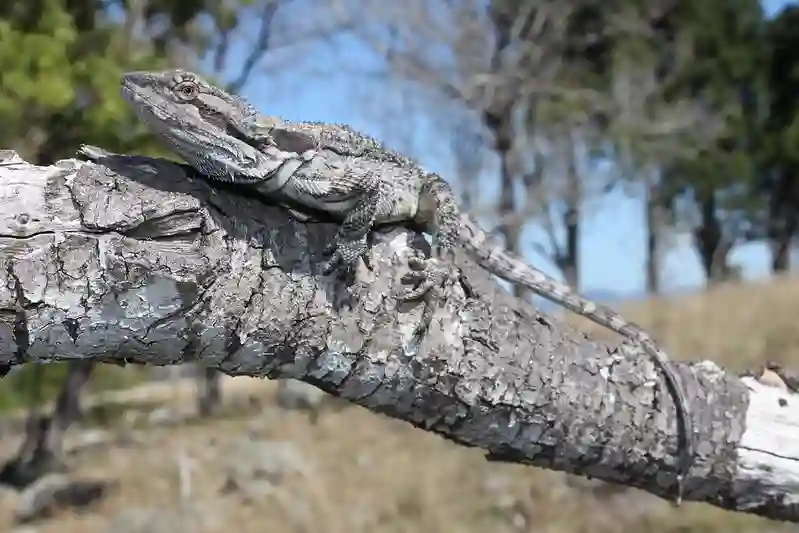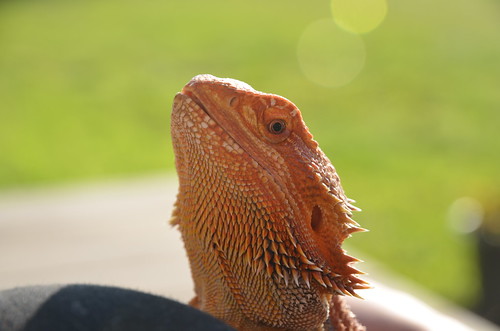A healthy bearded dragon should have the following characteristics:
- Plump fat pads and a full base of the tail, with no visible hip bones.
- Eyes that are not sunken in, but full and alert.
- No discoloration in the scales.
- Able to support its weight and use all four limbs.
- A clean and dry vent area without swellings or abnormal coloration.
- A glossy tongue, not pale.
- Regular eating, basking, pooping, and sleeping habits.
- Curious and interested in their surroundings.
Importance of Maintaining a Healthy Bearded Dragon
As an owner of a bearded dragon, it is your responsibility to ensure that they receive proper nutrition, habitat conditions, and medical care. A healthy bearded dragon has an increased lifespan and is less prone to diseases such as metabolic bone disease (MBD), respiratory infections, or parasites.
Ensuring optimal health for your pet also means taking extra precautions when caring for them and making sure they get the necessary attention they need. By doing so everyone will benefit from having a happy and healthy pet in their household.
Physical Appearance
Body Size and Shape
The size and shape of a bearded dragon can give you an indication of its health. A healthy bearded dragon should have a well-proportioned body with a broad, triangular head and a tapered tail. The length of its body should be about one and half times the size of its head, measuring at around 16-24 inches from nose to tail.
Skin Color and Texture
A healthy bearded dragon should have smooth, non-flaky skin that is free from abrasions or cuts. Their skin color varies between different shades of beige, brown, yellow, and orange. However, the color shouldn’t appear too dull or faded; it should be vibrant with well-defined stripes or patterns.
Claws and Toes
Bearded dragons have sharp claws on each toe that they use for traction when climbing or digging in the sand. Their claws should not appear overly long as it might indicate poor health or neglect from their owner. To make sure your pet’s claws are in good condition, provide them with rocks and logs for climbing that can help keep their nails trimmed naturally.
Tail Length and Thickness
The length of a healthy bearded dragon’s tail is usually around two-thirds the length of its body. Its thickness also indicates good health since it stores fat reserves that help them survive long periods without food. If you notice any changes in your pet’s tail thickness or if it appears unusually thin or limp, consult your veterinarian to rule out any underlying illnesses.
Behavior
Bearded dragons are known for their docile and relaxed nature, making them a popular pet choice. A healthy beardie will be active during the day, basking under the heat lamp or exploring its surroundings.
It is normal for them to take naps throughout the day, but they should not be lethargic or unresponsive. If your bearded dragon shows signs of sluggishness or lack of energy, it may be a sign of illness.
Activity level
Bearded dragons are diurnal animals, which means they are active during the day and sleep at night. They require at least 12 hours of light per day to maintain their circadian rhythm and stay healthy. In general, a healthy beardie will spend most of its time basking under their heat lamp or exploring their enclosure.
Appetite
A healthy bearded dragon will have a good appetite and enjoy eating regularly. They should have access to fresh water every day and should eat nutrient-dense foods like crickets, mealworms, and vegetables. If your beardie stops eating or shows disinterest in food over an extended period, it may indicate an underlying health problem.
Alertness
A healthy bearded dragon should always appear alert and aware of its surroundings. When approached or spoken to, it should respond by opening its eyes wide open or even turning towards you with curiosity.
If your beardie appears lethargic or unresponsive when stimulated in any way (physically or auditorily), it may need medical attention as soon as possible. Observing your Bearded Dragon’s behavior frequently can help you identify any changes that could indicate underlying health problems that need immediate attention so you can ensure that your pet remains healthy and happy for years to come.
Habitat
A healthy bearded dragon requires an appropriate and adequately sized habitat that mimics its natural environment. A typical enclosure for an adult bearded dragon should be at least 55 gallons in size, although larger is always better. The enclosure should have a basking area, where the temperature is higher than the rest of the enclosure, and a cooler area where your pet can retreat when necessary.
Temperature Range
Bearded dragons are native to hot and arid regions of Australia, which means they require a warm and dry environment to thrive. The basking area of your pet’s enclosure should be between 95-110 degrees Fahrenheit (35-43 degrees Celsius), while the cooler end should remain around 75-85 degrees Fahrenheit (24-29 degrees Celsius). Make sure you provide a heat lamp or ceramic bulb to maintain these temperatures.
Humidity Levels
Bearded dragons require low humidity levels to prevent respiratory infections. The ideal humidity range for your pet is between 30-40%, although it can go up to 50% after bathing or misting. To achieve this level of humidity, you need proper ventilation in your pet’s habitat and avoid placing water bowls directly under heat sources.
Light Exposure
Adequate exposure to UVB light is essential for bearded dragons’ health as it helps them produce Vitamin D3 needed for calcium absorption. You can achieve this by using special UVB bulbs specifically designed for reptiles or by providing access to natural sunlight if weather permits. Be mindful that UVB bulbs need replacing every six months because their effectiveness diminishes over time.
The Art of Maintaining Habitat Conditions
Maintaining habitat conditions requires observation, research, and dedication on your part. You should frequently measure and monitor the temperature and humidity levels in your bearded dragon’s enclosure using a thermometer and hygrometer. Keep in mind that inadequate habitat conditions can lead to various health problems for your pet, so it is crucial to maintain a healthy habitat.
Health Concerns to Watch Out For
Bearded dragons are generally healthy creatures, but they can fall victim to a number of diseases and health problems if their owners aren’t careful. Below are some of the most common health concerns to watch out for.
Metabolic Bone Disease (MBD)
One of the most significant health issues that bearded dragons can face is metabolic bone disease (MBD). MBD occurs when a bearded dragon does not receive enough calcium or vitamin D3, which can lead to weak bones, muscle tremors, and other serious health problems.
To prevent MBD from developing in your bearded dragon, make sure they have access to calcium-rich foods like dark leafy greens and crickets dusted with calcium powder. Additionally, ensure that your beardie has access to adequate UVB lighting for at least 12 hours per day.
Parasites
Another common issue for bearded dragons is parasitic infections. Parasites live inside the body and feed off nutrients from your beardie’s digestive system.
This can lead to symptoms such as diarrhea, lethargy, weight loss, and even death if left untreated. Regular check-ups with a reptile veterinarian can help you catch any parasites early on before they become a significant problem.
Respiratory Infections
Respiratory infections are another concern for bearded dragon owners. These infections cause inflammation in the respiratory system and can lead to symptoms like coughing, wheezing, and difficulty breathing. Respiratory infections are often caused by poor living conditions or inadequate temperatures/humidity levels within their habitat.
It’s essential to keep your bearded dragon’s enclosure clean and well-maintained while also ensuring proper temperature ranges (80-90°F) and humidity levels (30-40%). If you suspect that your beardie has a respiratory infection, seek veterinary treatment immediately.
Care and Maintenance
Bearded dragons are relatively easy to care for, but they do require some basic maintenance to keep them healthy and happy. This section will cover the dietary requirements of bearded dragons, as well as their cleaning schedule and the importance of regular veterinary check-ups.
Dietary Requirements
Bearded dragons are omnivores, meaning they eat both plant and animal matter. In general, adult bearded dragons should be fed a diet that consists of about 80% vegetables and 20% protein. Some good vegetable options include collard greens, turnip greens, mustard greens, kale, and squash.
When it comes to protein, you can feed your bearded dragon crickets, mealworms, superworms, or roaches. As a general rule of thumb, you should aim to feed your bearded dragon once a day.
Cleaning Schedule for the Tank/Enclosure
Keeping your bearded dragon’s tank clean is essential for its health. You should spot-clean the enclosure every day by removing any uneaten food or feces from the tank. Once a week or so (depending on how dirty the tank gets), you’ll need to do a more thorough cleaning.
This involves removing everything from the tank (including substrate) and scrubbing it down with warm water and mild soap. Rinse everything well before putting it back in the tank.
Veterinary Check-Ups
Regular veterinary check-ups are important for ensuring that your bearded dragon stays healthy. Your vet can give your pet a thorough physical exam and make sure that there are no underlying health issues that need to be addressed.
Additionally, if you notice any changes in your bearded dragon’s behavior or appetite, it’s important to schedule a vet appointment right away. Early intervention can be key when it comes to treating health problems in reptiles.
Conclusion
Summary of Key Points on What a Healthy Bearded Dragon Looks Like
A healthy bearded dragon will have a well-proportioned body with smooth skin and clear eyes. Its claws and toes will be in good condition, and its tail will be of good length and thickness. The dragon should be active, alert, and have a healthy appetite.
It should live in an environment with appropriate temperature range, humidity levels, and light exposure. To maintain its health, it is important to watch out for health concerns such as Metabolic Bone Disease (MBD), parasites, and respiratory infections.
Importance of Taking Care of Your Pet to Ensure Its Health and Happiness
Taking care of your pet is crucial to ensure its health and happiness. A bearded dragon requires proper diet, cleaning schedule for the tank/enclosure, regular veterinary check-ups along with mental exercise. By paying attention to their physical appearance, behavior patterns & habitat one can understand if their pet is healthy or not.
The best way to make sure your bearded dragon stays healthy is to feed it nutritious food consistently, remove uneaten food after each meal, clean the terrarium regularly, provide enough heating, give it the right lighting conditions and take it to the doctor when it needs it. You have to spend a lot of time taking care of your pet, but it’s worth it since a happy and healthy pet makes your life happier.



